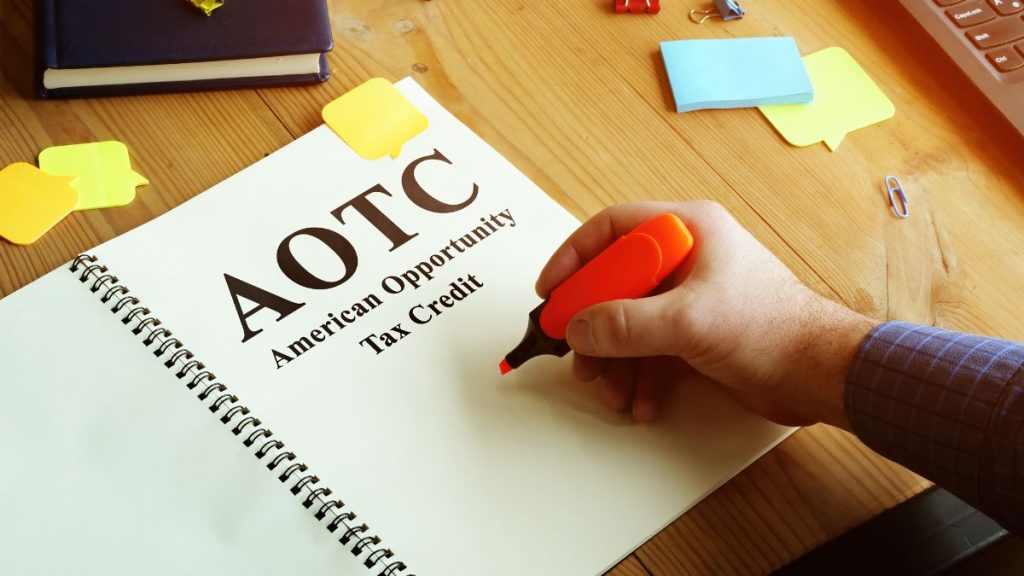The American Opportunity Tax Credit (AOTC) is a valuable financial tool designed to help students and families offset the costs of post-secondary education. Available for the first four years of higher education, the AOTC can offer up to $2,500 annually per eligible student. For students and parents struggling to manage rising education expenses, this tax credit can provide much-needed relief.
In 2024, the AOTC remains a critical resource for those pursuing post-secondary education. In this detailed guide, we will explore AOTC eligibility, how much you can claim, income limits, and how to take full advantage of this credit.
What Is the American Opportunity Tax Credit (AOTC)?

The AOTC is a tax credit that can be claimed to offset education-related expenses, including tuition, course materials, and fees. It’s a tax credit for the first four years of post-secondary education, meaning if you’re pursuing a bachelor’s degree or equivalent, you may be eligible.
One of the most attractive features of the AOTC is that it’s partially refundable. This means that if the credit reduces your tax liability to zero, you can still receive up to 40% of any remaining amount (up to $1,000) as a refund. Essentially, it offers both non-refundable and refundable benefits, making it more flexible for students and parents alike.
How Does the AOTC Work?
Here’s how the AOTC breaks down:
- The credit provides 100% reimbursement for the first $2,000 spent on qualified education expenses.
- It offers 25% reimbursement on the next $2,000 in expenses.
- The maximum credit amount per year, per eligible student, is $2,500.
For example, if you spend $3,000 on tuition and related expenses, you can receive a credit of $2,250: 100% of the first $2,000 ($2,000) and 25% of the next $1,000 ($250).
This credit can be claimed for each eligible student in the household, which means if you have multiple children in college, you can claim the credit for each of them.
AOTC Eligibility 2024
To qualify for the American Opportunity Tax Credit in 2024, both the student and the taxpayer claiming the credit must meet certain conditions.
Eligibility Requirements:
- Eligible Education Program: The student must be enrolled at least half-time in a degree or other recognized post-secondary education program for at least one academic period during the tax year.
- First Four Years of Education: The AOTC can only be claimed for the first four years of post-secondary education.
- No Felony Convictions: The student must not have a felony drug conviction at the end of the tax year.
- Educational Pursuit: The student must be pursuing a degree, certificate, or other recognized credential.
- Income Limits: The taxpayer’s income must fall below specific thresholds to qualify (see below).
Income Limits for AOTC 2024
Income limits play a crucial role in determining whether you are eligible for the full or partial AOTC.
| Filing Status | Adjusted Gross Income (AGI) for Full Credit | AGI for Partial Credit | AGI Above Which No Credit is Available |
|---|---|---|---|
| Single | Up to $80,000 | Between $80,001 and $90,000 | Above $90,000 |
| Married Filing Jointly | Up to $160,000 | Between $160,001 and $180,000 | Above $180,000 |
Taxpayers with income exceeding the upper limits will be phased out of eligibility for the credit, meaning they cannot claim the AOTC at all. Those within the phase-out range can still claim a reduced amount of the credit.
Qualified Expenses for the AOTC
To maximize the benefits of the AOTC, it’s essential to understand what counts as “qualified expenses.” These are the costs that you can apply toward the tax credit:
- Tuition and Fees: Fees and tuition required for enrollment at an eligible institution.
- Course Materials: Textbooks, supplies, and equipment that are required for the courses.
- School-Related Expenses: Any fees required as a condition of enrollment or attendance, such as lab fees.
Expenses such as room, board, insurance, and transportation are not eligible for the AOTC.
Claiming the AOTC in 2024
To claim the AOTC, you need to file Form 8863 with your tax return. The educational institution will provide you with a Form 1098-T, which contains essential information about tuition and fees paid. You’ll need this form to complete your claim.
Step-by-Step Process to Claim AOTC:
- Obtain Form 1098-T: Your school will send this form, detailing the qualified expenses paid.
- Complete Form 8863: Use the 1098-T to fill out this form. It’s required to claim education credits.
- Submit with Your Tax Return: Form 8863 must be filed with your federal tax return to claim the AOTC.
Example of AOTC Calculation

Let’s say you paid $3,500 in tuition and $500 in course materials in 2024. Here’s how the credit would break down:
- First $2,000 of expenses: $2,000 credit (100% of the first $2,000)
- Next $2,000 of expenses: $500 credit (25% of the next $2,000)
Total credit: $2,500
If this amount reduces your tax liability to zero, you would also be eligible for a refund of 40% of the remaining credit, up to $1,000. So, if you have no tax liability, you could receive a refund of $1,000.
Benefits of AOTC for Parents and Students
The AOTC offers several advantages:
- Reduces Tax Liability: The credit can lower your federal tax bill by up to $2,500 per eligible student.
- Partially Refundable: Even if you owe no tax, you can receive up to $1,000 as a refund.
- Multiple Claims: If you have more than one student in your household, you can claim the AOTC for each one, multiplying the benefit.
- Broad Coverage: Covers a wide range of expenses, from tuition to textbooks.
Key Differences Between AOTC and Lifetime Learning Credit (LLC)
It’s important to differentiate the AOTC from the Lifetime Learning Credit (LLC), another education-related tax credit. While the AOTC is specifically for the first four years of post-secondary education, the LLC can be claimed for any education level, including graduate studies and professional degree programs.
| Feature | American Opportunity Tax Credit (AOTC) | Lifetime Learning Credit (LLC) |
|---|---|---|
| Maximum Credit | $2,500 per student | $2,000 per return |
| Refundable? | Partially refundable (up to $1,000) | Non-refundable |
| Income Limits for Full Credit | $80,000 (single), $160,000 (married) | $80,000 (single), $160,000 (married) |
| Years Eligible | First four years of post-secondary education | Unlimited |
Conclusion
The American Opportunity Tax Credit 2024 offers a substantial benefit to students and families looking to reduce the financial burden of post-secondary education. With up to $2,500 in credit per student, including $1,000 that can be refunded, the AOTC is an essential tool for anyone pursuing higher education in the U.S.
By understanding the eligibility requirements, income limits, and qualified expenses, you can make sure you’re maximizing your credit and easing the financial strain of college. Don’t forget to claim the credit by filing Form 8863 along with your federal tax return.
FAQs
1. Can I claim the AOTC if I’m a part-time student?
Yes, as long as you are enrolled at least half-time for one academic period.
2. Is the AOTC available for graduate students?
No, the AOTC is only for the first four years of undergraduate education.
3. Can I claim the AOTC and the Lifetime Learning Credit in the same year?
You can’t claim both for the same student in the same year, but you can claim one credit for each student.
4. Is there a limit on how many times I can claim the AOTC?
Yes, the AOTC can only be claimed for four tax years per eligible student.
5. What happens if my income exceeds the AOTC limits?
If your income exceeds the phase-out threshold, you won’t be able to claim the AOTC.
References
- Visit IRS.gov for official details on claiming the AOTC.
- Check out IRS Form 8863 for claiming education credits.






